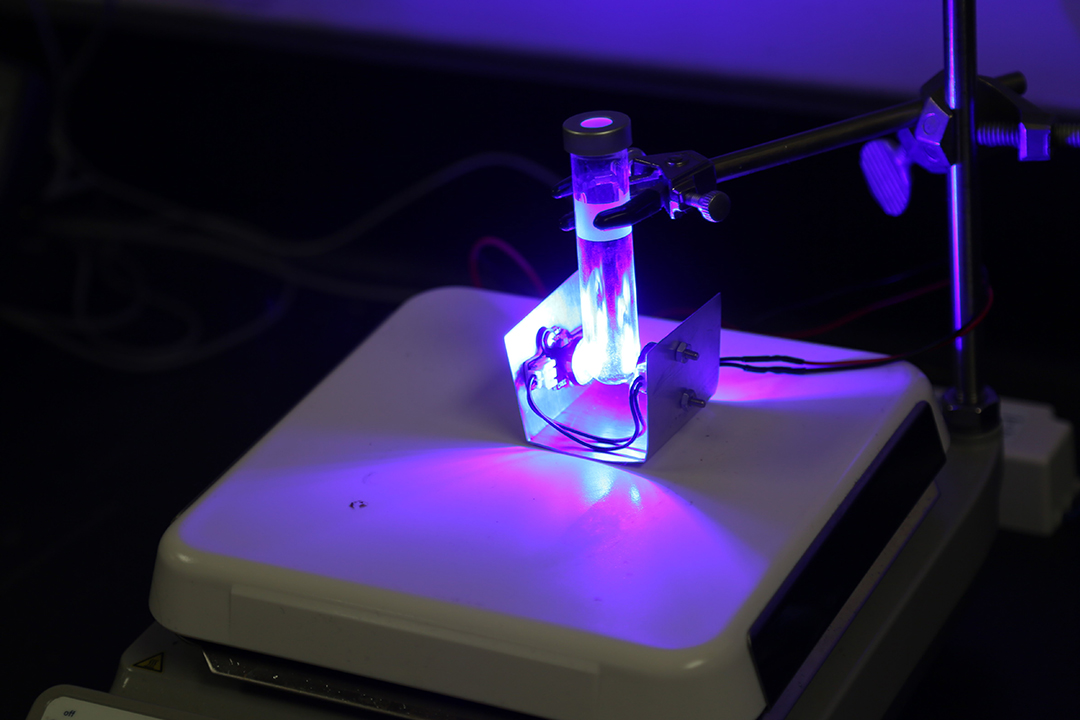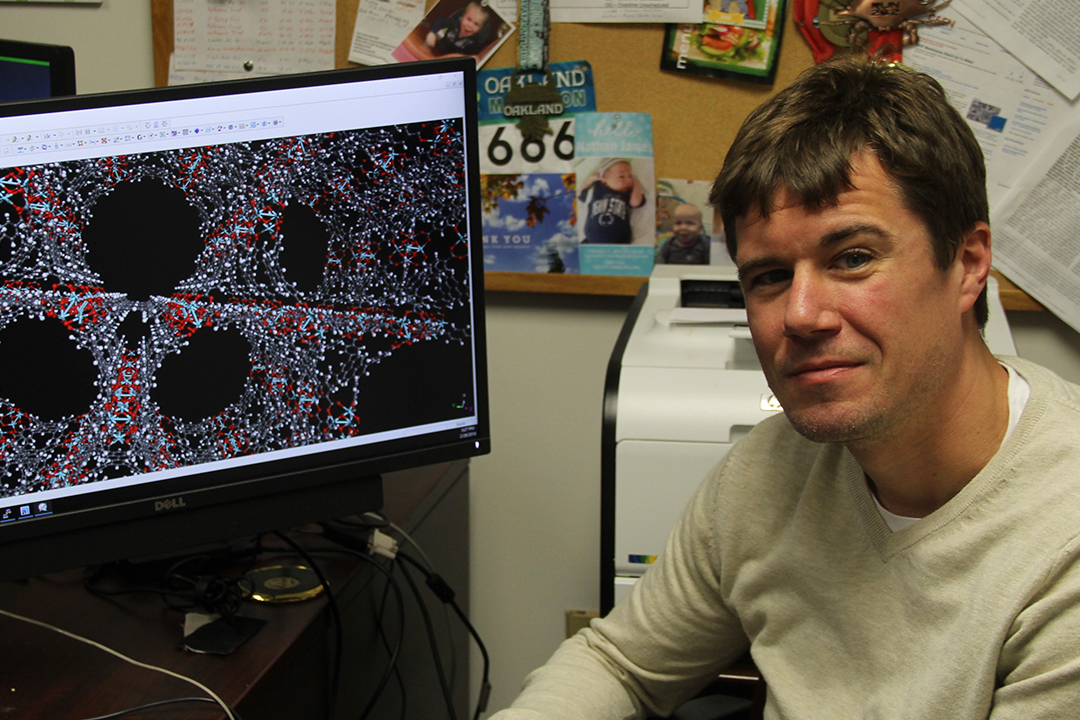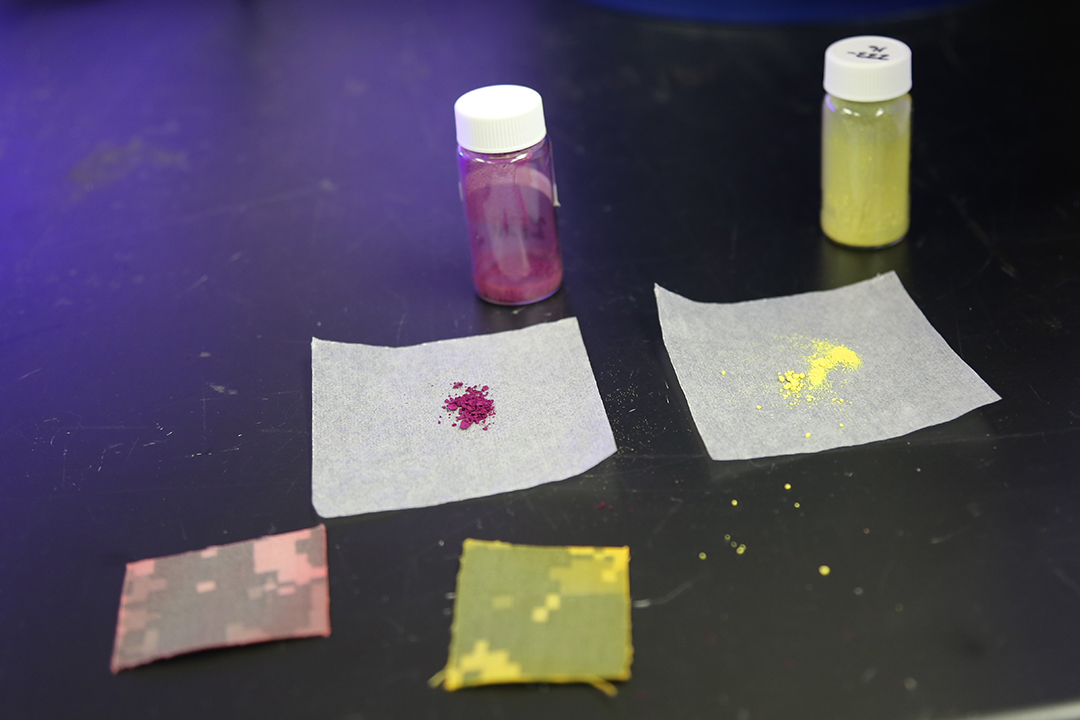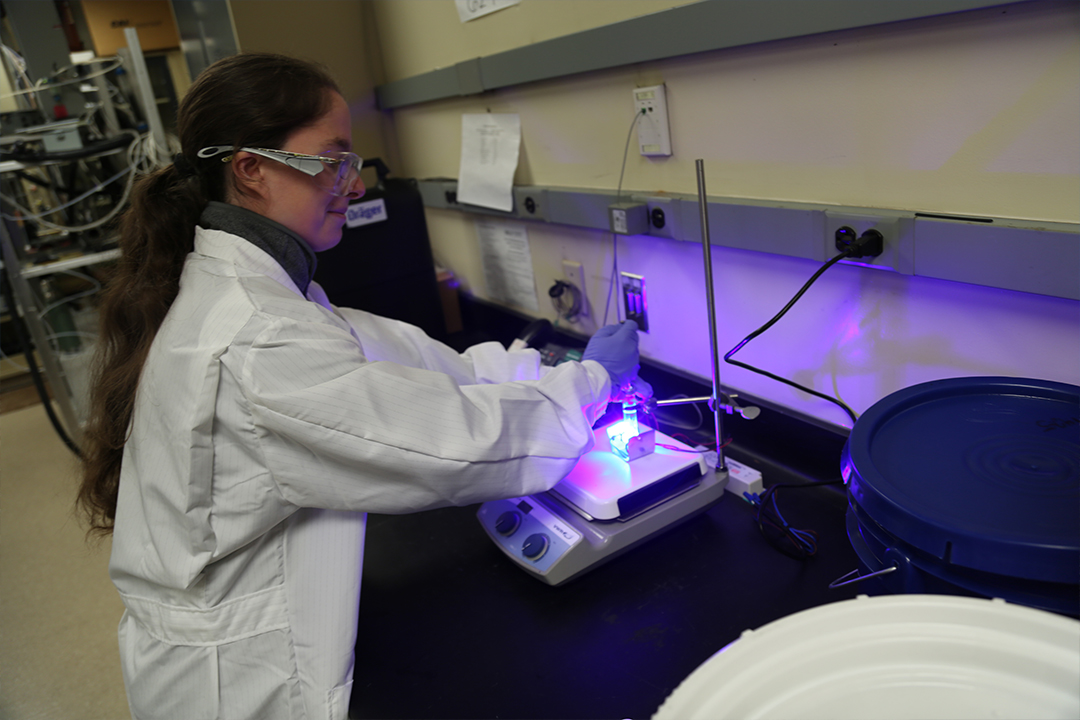// NEWS RELEASE
ECBC Research Could Lead to Self-Decontaminating Combat Uniform
Metal-organic frameworks use sunlight to neutralize chemical warfare agents
CCDC Chemical Biological Center Public Affairs | March 19th, 2018
ECBC Research Could Lead to Self-Decontaminating Combat Uniform
Metal-organic frameworks use sunlight to neutralize chemical warfare agents
DEVCOM CBC Public AffairsMarch 19th, 2018

Inside the test tube, researchers mix agent with MOFs and oxygen. Exposure to light starts the MOF's oxidation process, which neutralizes the agent.
EDGEWOOD – New research being conducted at the U.S. Army Edgewood Chemical Biological Center (ECBC) is exploring whether chemical weapon-neutralizing substances can be incorporated into equipment worn by warfighters.
Discovered in 2000, metal-organic frameworks, commonly called MOFs, are a relatively new research area – their ability to neutralize chemical warfare agents was just discovered five years ago. A team of ECBC researchers is determining how to incorporate MOFs into fabrics and textiles to give decontamination capabilities to materials worn by warfighters.
Essentially, certain forms of MOFs catalyze the oxidation of chemical warfare agents, thereby neutralizing toxic substances. When exposed to light, these MOFs react with and excite oxygen. In turn, oxygen reacts with and combines with agent, effectively neutralizing the threat. While there are thousands of different MOFs, ECBC researchers have identified fewer than 10 with this capability.
“This is a catalytic method that uses oxygen from the atmosphere as a reactant,” said ECBC chemist Jared DeCoste, Ph.D., who leads ECBC’s photocatalytic oxidation study. “The oxygen from the atmosphere is excited into a higher energy state by the MOF to make an active species that can then react with mustard (agent) and neutralize it.”

Normally, oxygen does not react with chemical warfare agents. However, when MOFs absorb visible light, they can use this energy to convert oxygen into a more active state called the singlet state.
“The light comes in and interacts with the MOF, and it takes that light and converts oxygen in the air into an active oxygen species,” Decoste explained. “This is all based around finding the easiest way to create singlet oxygen.”
Composed of metal ions and organic compounds, MOFs take the form of powder. Decoste, along with Hui Wang, a National Research Council postdoctoral associate, and Ann Ploskonka, a contractor chemist working at ECBC, are in the process of determining whether that powder could be infused with fabrics and textiles.
Specifically, Wang is researching whether other photosensitizers, such as boron-dipyrromethene analogs, can be incorporated into fabrics to improve the photooxidation process. While MOFs offer some advantages over other materials in that they are highly porous and can adsorb and potentially sequester large amounts of chemical warfare agents, the use of dyes has the potential of being a much simpler and cost-effective process.

Ploskonka is working on synthesizing and creating novel MOF structures that can increase the efficiency of the mustard agent photocatalysis degradation process. There are thousands of MOFs that have been reported to date, and they can be modified in many ways, so determining the optimal pore structure and density of functional features within the structure can be quite the laborious task.
When the capability is developed, the MOF-enhanced materials could be used for clothing or even as a filter for a gas mask, Decoste said. The next steps are determining that right combination of MOF and fiber to maintain optimum flexibility while retaining decontamination ability.
As this technology is based a relatively new area of research, the capability is at a basic level.
“There is no self-decontaminating fabric that’s fielded or anything along those lines at this point,” DeCoste said. “This is really basic research at this point. We’re trying to determine the best nanomaterials to achieve decontamination, while in parallel working on methods to integrate these materials into textiles that can be fielded.”
This research was prompted by a need to identify field-deployable methods of mustard agent decontamination. While some types of agent can be decontaminated using water from the atmosphere, mustard agent is less susceptible to that method.
Currently, this capability is only being tested for mustard agent decontamination. Some other types of agent, like VX, may be susceptible to this method. Others, like Sarin, are not.

“It’s something that we plan on looking at,” DeCoste said. “In a lot of these basic studies, we try to study one reaction as best we can. Once we can fully understand the process well, we can move faster later on.”
As the technology is still in development, it’s unclear when it will be completed, tested, and deployed in the field.
“When you hear about using sunlight to decontaminate, that sounds like a futuristic application, and it is,” Decoste said. “It’s one of those applications where the materials are really novel and require development.”
The Defense Threat Reduction Agency (DTRA) is interested in the technology and has funded a program focused on up-scaling the production MOF materials.
“We’re working with a pretty substantial program from DTRA to incorporate these active materials into more functional forms, such as textiles,” DeCoste said. “We have been talking to DTRA about getting these types of materials into the next generation of combat uniforms that are going out to warfighters.”
The U.S. Army Combat Capabilities Development Command (DEVCOM) leads in the discovery, development and delivery of technology-based capabilities to enable Soldiers to win our nation’s wars and come home safely. DEVCOM is a major subordinate command of the U.S. Army Futures Command. The DEVCOM Chemical Biological Center is the Army’s principal research and development center for chemical and biological defense technology, engineering and field operations. The DEVCOM Chemical Biological Center is headquartered at Aberdeen Proving Ground, Maryland.
